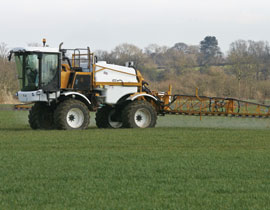Counting the cost of weed control

Farmers are facing some difficult decisions this winter. Should they persevere with poor-looking crops, or just rip them up? Maximise yields or minimise costs?
With so many variables and the weather almost universally appalling, finding the right balance is no easy task.
The cost of tackling weeds in these backward crops this spring will be part of that decision. Autumn herbicide spend is well down for many, but crops may require quite a bit of investment this spring, with grassweeds offering a stronger challenge to thin, less competitive crops.
Thomas Long, consultant at Brown & Co, says farmers’ herbicide costs will be directly linked to the opportunity of applying each product, as prices are relatively static year-on-year.
“In East Anglia, farmers have only applied 30-50% of their autumn herbicide to wheat, and 70-90% to rapeseed. And the window of opportunity has now passed because the weather is turning milder, and it’s still going to be a while before people can travel on many soils.”
Mr Long expects herbicide costs to drop to about £70/ha this season – although greater broad-leaf pressure could boost it back close to more normal levels if farmers are able to get the sprays on.
“Many crops are very patchy, and blackgrass is a widespread problem,” says Graham Redman of Andersons consultants. “Getting any kind of yield is a great concern, and the forthcoming crop is likely to be a lot worse than the last one. Is there really any point treating it for the highest possible yield, knowing that the potential isn’t likely to be there?”
With many farmers unable to get pre-emergence and early post-emergence applications on to late-drilled crops, grassweeds are a particular problem this year. “They do need to be managed, not just for this crop, but for the quality of the ground next autumn,” he says. “A number of marginal crops are going to be written off, simply so farmers can get glyphosate on to control the blackgrass. The amount of fallow land is going to increase this year, for that reason alone.”
With the ground so saturated, many farmers won’t even bother drilling spring crops, adds Mr Redman. “It’s going to take up to a year to get some of these soils back into good condition. Without green cover fallow land won’t dry out very quickly, so it’s worth sowing something like mustard, or keep turning it whenever possible.”
That said, many crops have made it through the winter, and need to be looked after if they are to reach any sort of potential. “If a crop is good enough to grow, it’s good enough to care for. However, that doesn’t mean throwing as much as you can at it in expectation of a bumper yield. You need to treat it appropriately. Herbicides are usually more about the quality of the crop than yield – so bear in mind that cleaning out weed seeds after harvest is an expensive exercise.”
However in Shropshire, resistant blackgrass is less of a problem, so farmers’ herbicide costs are significantly lower, says independent agronomist Bryce Rham. “Last year my clients averaged a herbicide spend of £43/ha on winter wheat and £73/ha on oilseed rape.”
So far very few farmers have managed to apply Crawler, and with the ground as wet as it is, some may not manage at all. “That could reduce herbicide costs by at least £30/ha as there’s nothing you can do after that,” says Mr Rham.
Winter barley options are similarly limited. “Liberator can be used up to the end of March, depending on growth stage, so we’ll just have to keep our fingers crossed.”

